
When ice climbing, it’s important to know how difficult your route is. I’ve put together the following guide to explain ice climbing grades.
The ice climbing grades are:
- WI-1: No tools required to climb
- WI-2: Good protection, tools required in some spots
- WI-3: Sustained climbing with good rests and protection
- WI-4: Continuous steep or vertical ice
- WI-5: Long, vertical, strenuous ice
- WI-6: Highly technical, long, and vertical, with no rests
- WI-7: Long, technical, and on bad ice
Ice climbing grades are based on a system that takes into account several factors, including the steepness and quality of the ice, the amount of protection you can place, and how technical the movements are. Beginners might be able to climb anywhere from WI-2 to WI-4 on top rope, depending their degree of physical fitness. Most experienced ice climbers can climb in the WI-5 range, while WI-6 and WI-7 are reserved for a few cutting-edge routes around the world.
In the following guide I explain more about the ice climbing grading system, before going into an in-depth explanation about each of the grades.
Ice Climbing Grades: An Introduction
Ice climbing grades, just like climbing and scrambling grades, are intended to give a rough idea about how difficult a certain route will be to climb. They do this by comparing:
- How steep the ice is: the steeper the ice, the more physically challenging a climb is, and the higher the grade of the climb will be.
- The ice quality: This is another important factor. Solid, thick ice that you can drive your tools into is much easier to climb than thin, cracking, late-season thaw.
- Availability of protection: This is less of a major factor, but it still plays a roll. The more exposed you are while climbing, the more mentally challenging it is, and the higher the grade will be.
- Technicality of the movements: How simple is the ice to climb? Are there any complex moves such as figure 4’s? Are there exposed bulges? What about chandeliers or columns? This is a major factor in determining the difficulty of a route.
- Length of the route: A long route with tough moves and bad ice will be rated harder than a short route with tough moves and bad ice.
- Availability of rest spots: Similar to above, if a route has several good resting points, it may score lower on the difficulty scale.
By taking into account all of the above factors, ice climbing grades can give people an idea of how challenging a certain route is going to be. Remember, ice climbing is much, much different than rock climbing, in that you don’t fall nearly as frequently. Because of that, it’s important to know the grade of a piece of ice before you decide to lead it.
One of the difficulties of this is that ice changes throughout the season. The quality, shape, and steepness of the ice can all change with the weather, how much the ice has been climbed on, and what shape the water took when it first froze.
Because of that, ice climbing routes are rarely assigned a single grade that will last forever, as they are in rock climbing. It’s very difficult to look at a waterfall in the summer and declare, ‘That’s going to be a WI-4 ice climb’. The difficulty of certain routes may change from year to year, or even within a single season if there are repeated periods of freezing and thawing.
This makes it essential to have a solid understanding of ice climbing grades so that you can judge a route upon sight to know if it’s safe to climb.
Water Ice vs Alpine Ice
As you can probably tell, there are two components to an ice-climbing grade: the ‘WI’ prefix and then the number denoting the difficulty. The WI stands for ‘Water Ice’, and it refers to any ice climbing route that’s season in nature (that is, it freezes in the winter and thaws in the summer).
There’s another prefix, ‘AI’, which stands for Alpine Ice. This refers to ice in high mountain areas that, because of its elevation and location, never fully thaws.
Alpine Ice may be easier to climb that a water ice route with the same grading. Don’t be fooled, though; this is done to account for the fact that the alpine ice will be harder to get to, more remote, and possibly exposed to avalanche danger. Alpine Ice climbing is a sport all its own, and it shouldn’t be taken lightly just because the rating is lower.
Ice Climbing Grades, Explained
Now that we’ve talked about what the grades mean and how they’re used, it’s time to get into specific details about how difficult they actually are to climb.
Before I start, however, I need to make a few disclaimers. Every single category that I give is a generality and can change based on any number of factors. There are no hard-and-fast rules to grading an ice climb, but I’m trying to give a broad overview so that you can have at least some idea of what the numbers mean.
Second disclaimer: if I say a beginner can climb something, I mean on top rope. I cannot stress this enough. If you’ve never been ice climbing before, it will take hundreds of routes before you’re ready to lead. All I’m trying to say is that, for the easier grades, some beginners will have the right amount of natural skill and physical fitness to struggle their way up on top rope. Other beginners might not be able to, so don’t start emailing me if you get cranky to find out that you can’t send WI-2. You’ve been warned.
Third disclaimer: I don’t want to hear a single peep about my comparison to rock climbing grades. I know all the issues with trying to compare ice climbing grades to rock climbing grades. I know them, okay? I rock climb. I ice climb. I understand that they’re different sports.
So, don’t start sending me angry emails about how stupid it is. I’m not trying to say that someone who climbs 5.12 could hop on a WI-5 climb. I know that’s not the case. I’m simply trying to provide a baseline so that someone who’s never ice climbed before will have a better idea of how challenging a grade is.
Everyone good? Great. Let’s get into it!
WI-1
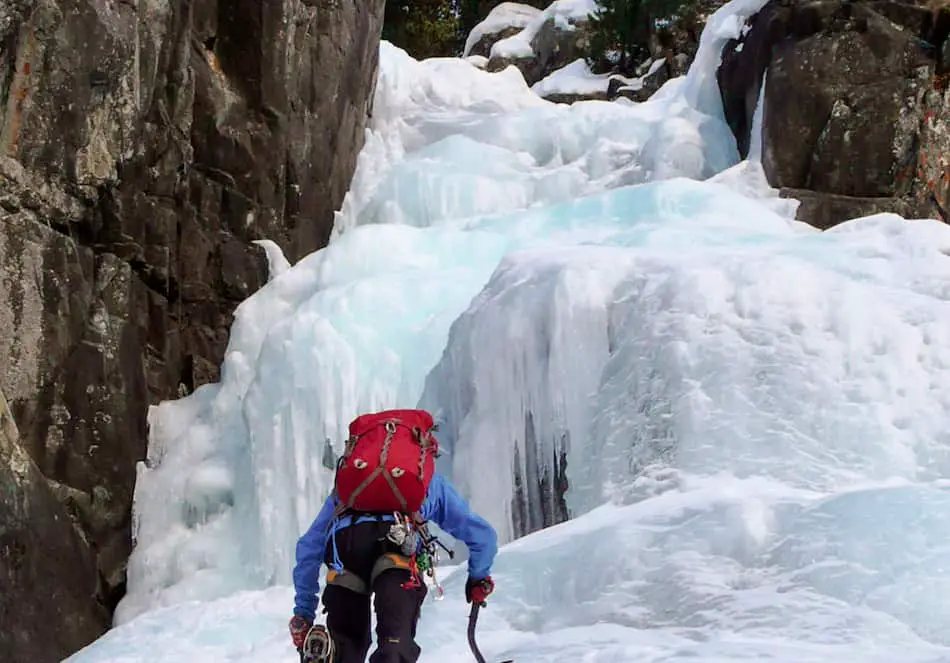
What is it? Easy climbing on low-angle ice that may not require tools.
Steepness of the ice: Anywhere up to 60 degrees.
Who can climb it? Beginners and upwards.
Comparable rock-climbing grade: Class 4-5 scrambling.
Starting us off nice and easy is WI-1, the first and gentlest of all ice climbing grades. This grading is used to denote low-angled ice that’s steep enough to need crampons on but not steep enough that you’ll actually have to ice climb to get up it.
WI-1 is more akin to rock scrambling, where you need to watch your foot placement and take care to not fall, but you likely aren’t going to place protection or use your hands much. Experienced ice climbers or alpinists will be able to walk right up a W1-1 route with barely a second thought.
WI-1 probably isn’t a great grade to learn how to ice climb, because it’s so low-angle that it’ll be hard to get the exact movements that you would on a more challenging ice climb. If you’re struggling to start ice climbing or you don’t want to go on anything more exposed, I would recommend using this grade. Otherwise, however, you might find it just as beneficial to push on to something more challenging.
WI-2
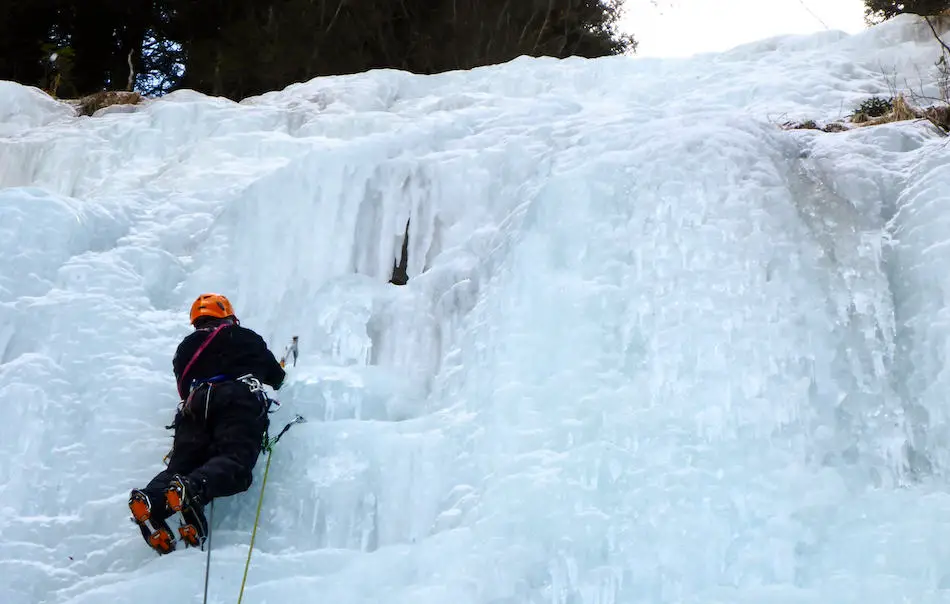
What is it? Consistent moderate ice, with a few bulges and good spots to rest. The ice is in good quality and there is lots of available protection.
Steepness of the ice: Sustained 60-degree slopes, with bulges that make it steeper.
Who can climb it: Beginners and up.
Comparable rock-climbing grade: 5.5 sport climb.
Next up is WI-2, which denotes longer sections of moderately steep ice with simple movements and good protection. The ice will be in the 60-degree range for most of the route, with some bulges pushing into the 70-80-degree range for a short period of time. The ice is good quality for your tools and ice screws.
WI-2 is the perfect grade for an experienced ice climber to warm up: it’s challenging enough to get their forearms involved, steep enough to allow for proper ice climbing technique, and yet simple enough that there’s very little chance of a fall occurring.
Because of this, WI-2 is also a very good place for any beginners who are looking to try their hand at ice climbing. It’s safe and simple, and it will allow you to try out the motions of ice climbing without needing to worry about your forearms getting super pumped out.
WI-2 ice usually forms from low-angle or multi-tiered waterfalls where the spring runoff is always touching the rock. This contact prevents the ice from getting it too steep and keeps it at a lower grading.
WI-3

What is it? Sustained nearly-vertical climbing with some sections of vertical ice. There will be a decent amount of rests, and the stances for placing screws will be solid.
Steepness of the ice: Minimum of 70 degrees, with sections into the 80-90-degree range.
Who can climb it: Some beginners, moderate ice climbers and up.
Comparable rock-climbing grade: 5.9 sport climb.
A WI-3 ice climbing route is fairly similar to a WI-2, expect that it’s going to be a little bit steeper, a little bit more sustained, and the rest positions won’t be quite as good.
WI-3 routes can still act as a warm-up, although only for those with several seasons of rock climbing beneath their belts. For those just getting into the sport or who are just learning to lead, the WI-3 grading is a good test piece to see how you fare on longer, trickier ice.
A WI-3 climb will likely have a few sections where potential falls are a real danger and you need to engage in vertical ice climbing. You might need to think a little bit about where you place your tools, and you’ll have to be smart about the stances you take to put your ice screws in.
Beginners with a knack for climbing and good physical fitness will most likely be able to follow a WI-3 route, although they might need to take it slow and rest on the rope every now and then.
Remember, as I said above, that ice climbing grades can also be very variable. If you have a 10-meter route of 80-degree ice with good rests and solid-quality ice screw placements, that could qualify as WI-3. A lower-angle route where the ice is more thin and the protection is less prevalent could also be WI-3.
WI-4

What is it? Continuous near-vertical climbing with several sections of vertical climbing, broken up by a few rests.
Steepness of the ice: 80-degrees at minimum, with sustained 90-degree climbing.
Who can climb it? Weekend warriors, experienced climbers, and the odd beginner.
Comparable rock-climbing grade: 5.11a sport climb.
Now we’re really starting to get into it.
For those who are just getting into ice climbing and see themselves doing it for a long time, WI-4 is the test-piece grade to try your leading skills on. It’s challenging, sustained, and requires a cool head and good tool placement to ensure that you don’t fall, and leading a WI-4 is a pretty good sign that you’re starting to figure out what you’re doing.
WI-4 routes feature long sections of ice that are rarely shorter than 80-degrees, with several sections of 90-degree climbing. The ice may be rougher or thinner, and good tool placements may be harder to find. There might be features such as bulges or ledges that need to be navigated around, and rest positions will be scarcer.
Essentially, a WI-4 ice climbing route is one where falling is a very real possibility that needs to be taken into account. For the most experienced climbers out there, this could be considered a warm-up, or a simple enough task. For most people, however, leading WI-4 is a challenging and scary endeavour.
WI-5
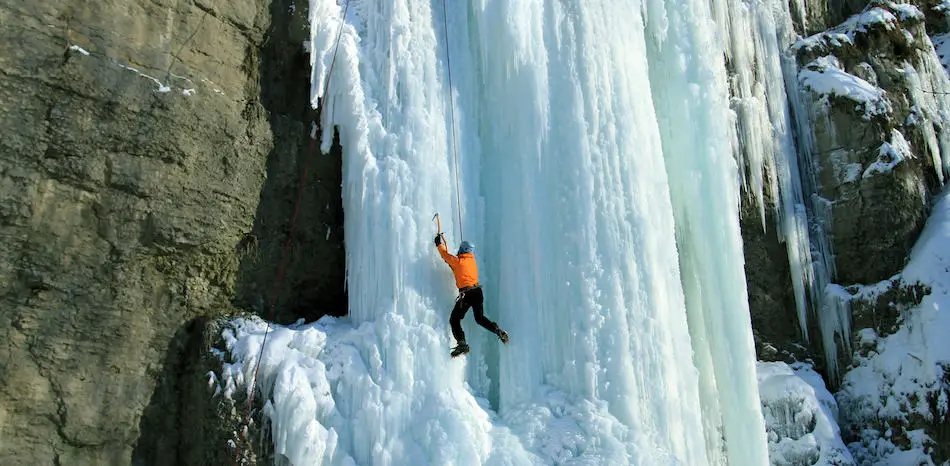
What is it? Sustained (50-60 meter) stretches of vertical or near-vertical climbing, with few rests. Alternatively, it could be a shorter route with bad ice and technical moves.
Steepness of the ice: 85-90 degrees.
Who can climb it? Experience ice climbers, weekend warriors.
Comparable rock-climbing grade: 5.12c sport.
If WI-4 was the test piece for any aspiring ice climbers, WI-5 is the goal for just about anyone who isn’t going to make climbing a career. With long, strenuous sections, constant fall risks, and questionable screw placement, WI-5 is going to be as high as many people ever climb on ice, even those who are dedicated to training and honing their skills.
A WI-5 route features full-rope-length sections of vertical climbing with little to no rest on it. Alternatively, it could be used to describe a shorter route of entirely vertical ice where the ice is thin, the placements are bad, and the moves involve candlesticks, cauliflower ice, or chandelier features.
Leading a WI-5 would be a nice feather in the cap of any alpinist. These routes are demanding, dangerous, and require years of training before you’re ready to tackle them.
WI-6
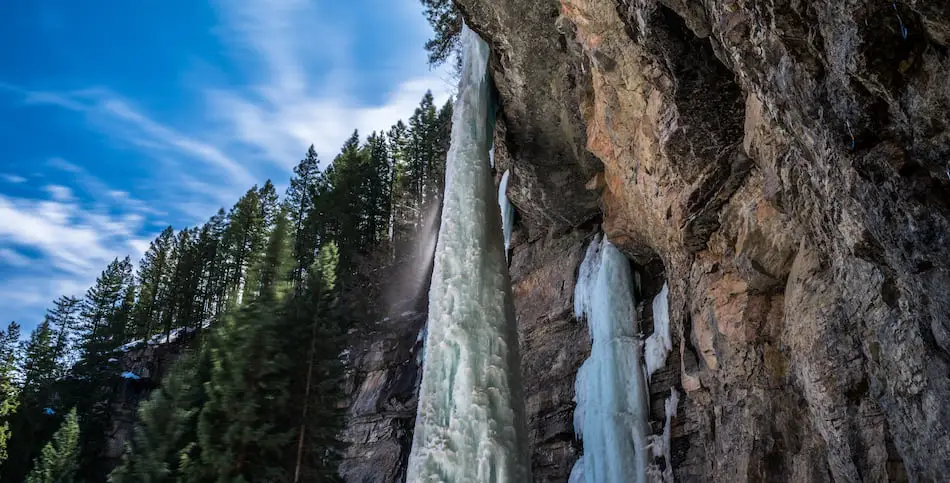
What is it? A full rope-length of vertical climbing with no rests involved. Alternatively, it could be a shorter route with even more challenging moves than WI-5.
Ice steepness: 90 degrees, some overhanging sections.
Who can climb it: Career alpinists / ice climbers.
Comparable rock-climbing grade: 5.13d on sport.
WI-6 is an exclusive club.
For those who have spent significant portions of their life on ice and want to continue to push the limits, WI-6 routes provide a myriad of difficult challenges to be overcome. They’re steep and sustained with absolutely no rest, meaning that a climber must have incredible technique and endurance to avoid falling.
The availability of protection is scarce, and the ice quality is going to be highly questionable in some spots. If the routes aren’t super long, they’re going to feature highly technical moves such as chandeliers or columns to navigate.
Just like a WI-4 is the test piece for anyone who ice climbs as a hobby, WI-6 is the test piece for some of the best alpinists in the world who want to challenge themselves.
WI-7

What is it? Long, technical, steep climbing on technical and poorly formed ice. Protection is going to be non-existent or highly dubious.
Ice steepness: 90-degreess plus.
Who can climb it? Will Gadd, Aaron Mulkey, Mark-Andre Leclerc; the best ice climbers in the world.
Comparable rock-climbing grade: 5.15 rock climbing.
As legendary climber John Long once said, we’re now talking about virtuoso climbing.
WI-7 routes are the ones that only the best of the best can put an axe to. They feature either long, vertical climbing on bad ice with no protection, or massively overhanging routes with a variety of features and challenges. They’re dangerous and demand a lifetime of climbing experience to be able to tackle.
This is a grade that’s reserved for career ice climbers who are looking to push themselves to the next level. They’re the king lines of ice climbing, featuring either the most dangerous of scenarios or the hardest individual moves that you can can find in nature.
It’s also the last consensus grade on the ice climbing scale, meaning that any new routes graded higher than this are going to need to be a level of difficulty that, as of now, hasn’t really been seen in the ice climbing world.
WI-8 and above
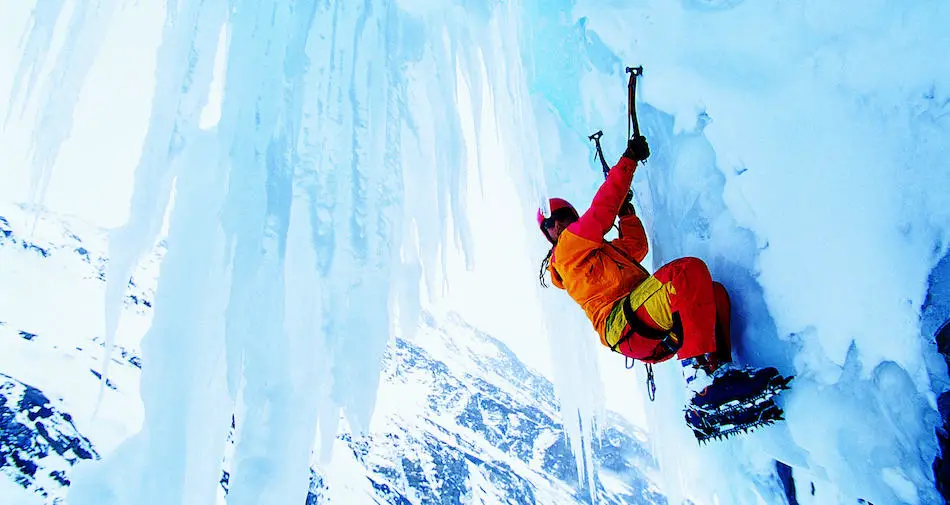
What is it? An indeterminate grade somewhere above WI-7. Features consistent, over-hanging climbing on bad ice.
Ice steepness: 30-50 degrees overhung.
Who can climb it? The best ice climbers in the world.
Comparable rock-climbing grade: V14 bouldering.
As technology continues to improve and people continue to push the limits, a new type of ice climbing has evolved.
Originally, the ice climbing grades were meant to denote the steepness of a route, quality of the ice, and availability of protection. You could usually account for steeper and technical sections, but the main thing they were measuring was the three above features.
Now, however, the limits are being pushed in different types of ways. Climbers are finding overhung caves of ice, full of crazy formations and insanely hard routes. These moves are right on the limit of human ability, demanding insane strength and flawless technique. However, they’re also protected by bolts and relatively safe to fall from, because of how overhung the route is.
This new form of ice climbing is more akin to redpoint rock climbing, where the quickdraws are already in place and climbers push their absolute limits, fully aware that there’s a chance of falling. It’s a beautiful form of ice climbing, but it’s also markedly different from long, thin routes on bad ice, where screws are placed haphazardly and falling is never an option.
So, how do you rate these grades? Is an overhung, sustained, and technical piece with good protection more challenging than a 90-degree WI-7 on bad ice with no bolts? Can we compare these two forms of ice climbing? How can we assign grades to them?
According to legendary ice climber Will Gadd, we shouldn’t even be trying. Says Gadd about the climbing in Helmcken Falls, BC, one of the most extreme overhung ice climbing destinations in the world:
“I don’t even try to grade these things. I haven’t for a couple of years now. They are what they are. If you can do it you get to the top, and if you can’t you fall off, and that’s good enough for me.”
https://www.redbull.com/ca-en/will-gadd-climbing-the-world-s-hardest-mix-route-climb
When Will Gadd talks, ice climbers listen. He’s essentially saying that there are too many factors involved in ice climbing to be assigning grades, and that technology and the evolution of more and more overhung ice climbing has made comparing different types of climbing irrelevant.
Because of that, you might now see people assigning crazy grades like WI-11 to some overhung routes. I’m not going to comment on whether they’re right or wrong to give a route that level of difficulty; god knows I’ll never be able to climb it myself. The climbing community has yet to reach a consensus on such matters, however, so for now I’m going to leave it out of the guide.
Conclusion
So, there we go! That’s my complete guide on ice climbing grades.
Please, for the love of god, don’t take anything I’ve said too seriously. Just because I wrote that some beginners can climb WI-3 does not mean that you should go out and do it. You might risk injuring yourself or putting your partners at risk. If you’re just getting into the sport remember to take it slow, learn the basics first, and always go with someone more experienced than you. Don’t lead until you have at least 100+ laps on top rope under your belt (150, according to Gadd).
Also, if you’re upset about the climbing comparison, too bad. I did what I did.
Thank you for reading! Remember, this guide is meant to inform and entertain, not to recommend that you behave in any specific fashion. Seek expert advice and do your own independent research before making any decisions.
